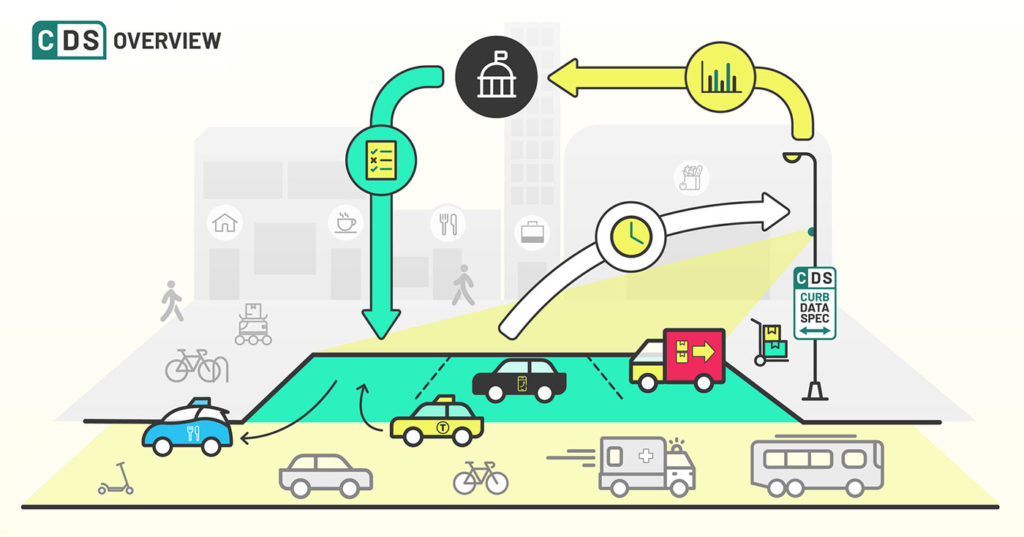DIGITAL TOOLS FOR A CHANGING WORLD
Imagine the day in the life of a curb: a food truck serving customers here, a bus stop there, e-scooters and bicycles passing by, people waiting for their orders in a parklet outside a deli, a restaurant receiving a delivery from a vendor, someone hopping out of a taxi. In one day, our humble urban curbs experience a lot.
In fact, urban curb space is evolving.
From ride-sharing and shared e-scooters to autonomous vehicles and drones – we’re all aware of the ways in which urban transportation continues to be shaped by technology. In the wake of the coronavirus pandemic, we’ve seen a surge in deliveries and the need for outdoor space to accommodate dining, socially-distanced travel, and other activities. These phenomena have come together to place unique demands on already scarce urban curb space.
As the demands placed on urban curb space evolve, so too must the tools we use to manage it.
We believe that public streets and sidewalks can be safer, more dynamic, and deliver more value to residents and local businesses. That’s why the OMF is building digital tools to help cities effectively manage curb space.

Today, we’re proud to share the release candidate for the first version of the Curb Data Specification (CDS). After more than a year of research and development, CDS Version 1.0 is designed to connect cities with curb users, giving them the common language they need to understand how curb space is used, optimize incentives and policies, communicate regulations to curb users in real time, and measure impact.
“The Open Mobility Foundation’s goal is to equip public agencies with the tools they need to deliver more public value from urban curb space and meet the evolving needs of residents. Curb space has long been a scarce resource. And, while many cities have made progress in their curb management efforts, technology and data offer new tools to proactively manage curbs and support public spaces that better reflect community priorities like safety, environmental sustainability, and local business development.”
-Angela Giacchetti, Executive Director of the Open Mobility Foundation
ABOUT THE CURB DATA SPECIFICATION
CDS —“Curb Data Specification”—is a digital tool that helps cities and companies pilot and scale dynamic curb zones that optimize commercial loading activities. CDS provides a mechanism for cities to express curb regulations, measure activity, and develop policies that create more accessible, useful curbs.

At its core, CDS is a set of APIs which allow cities to digitally represent their curb space and communicate with curb users in different ways:
Curbs API: A standard way for cities to digitally publish curb locations and regulations, which can be shared with the public and with companies using curb space.
Events API: A standard way to transmit real-time and historic commercial events happening at the curb to cities. Event data can be derived from company data feeds, sensors, check-ins, and other city data sources.
Metrics API: Track curb usage session details and define common calculation methodologies to measure historic dwell time, occupancy, usage and other aggregated statistics.
AN OPEN SOURCE PROJECT
CDS was developed as a free and open standard by OMF’s Curb Management Working Group. Formed to develop data specifications for curb space in the OMF’s open-source model, the group is led by a steering committee of individuals representing public and private sector organizations. More than 160+ individuals from 70+ public agencies, curb users, and technology companies have participated in the development of CDS.
“CDS was built through OMF’s unique, open source model. The OMF brought together a diverse group of leaders from across public and private sectors to develop the specification. Together, we outlined priorities, assessed related projects, set a scope of work, and worked as a community to bring the project to life. This group understood the current challenges of moving people and goods in our evolving cities and committed themselves to finding solutions. I’m honored to have been a part of this collaborative effort and believe it results in a stronger specification.”
– Brian Hamlin, Strategic Advisor, Curbside Management for the Seattle Department of Transportation and former chair of the OMF Curb Management Working Group Steering Committee
WHY CITIES AND COMPANIES ARE USING CDS
Initially developed to help cities and companies pilot and scale dynamic curb zones, CDS is designed to optimize commercial loading activities of people and goods, and measure the impact of these programs. These high-demand curb spaces provide a targeted area to advance shared goals like safety, sustainability, and accessibility. CDS’ flexibility means it can be used in many scenarios, including:
- Digitally sharing regulations, including loading zone rules and locations
- Determining real-time curb status
- Tracking and analyzing curb usage
- Responding to curb violations and improving curb enforcement
- Optimizing curb usage and access to meet policy goals
Many organizations that participated in the development of CDS are planning to use it in upcoming curb projects.
“Cities recognize the need to develop a common data standard that gives them the information needed to support policy innovation. We’re thrilled to put CDS into action in our upcoming Smart Loading Zone pilot, which aims to digitally map curb space and create reservation-based loading zones to relieve congestion and improve safety.”
– Michael Carroll, Managing Director for Philadelphia’s Office of Transportation and Infrastructure Systems and member of the OMF Board of Directors.
THE FUTURE OF CDS
Today, CDS helps cities and companies pilot and scale dynamic curb zones. But, we believe CDS can be a critical tool for managing many more aspects of the urban curb, helping cities respond to changing demands more effectively and efficiently. Be part of this future by implementing CDS and getting involved in the Curb Management Working Group’s upcoming work.
The OMF has developed several resources to help cities and companies implement this new standard, including privacy guidance, policy guidance, and a pilot project guide. These resources will continue to grow as the specification evolves.
Community input and engagement are what drives this evolution. If you are a city, company, or individual who is interested in shaping the future of CDS, learn more about how to get involved. The Curb Management Working Group is open to both OMF members and individual contributors. To participate:
- Review the Curb Management Working Group wiki
- Get announcements, invitations, and review meeting agendas from the Curb Management mailing list
- Join bi-weekly meetings (Tuesdays, 12pm ET) to discuss issues and hear from other contributors
- Follow progress and chime in on our CDS repository on GitHub
The CDS 1.0 release candidate will now go through OMF’s governance process, which includes votes by our Technology Council and Board of Directors, before being considered an official version. It may undergo some changes in this process. In the meantime, the release candidate has been approved by the Curb Management Working Group Steering Committee and is now available for public review and use.




